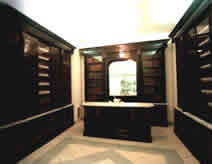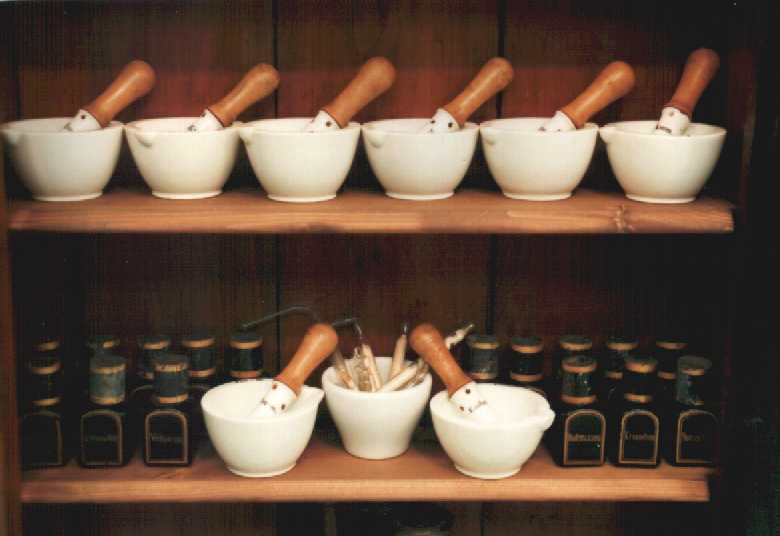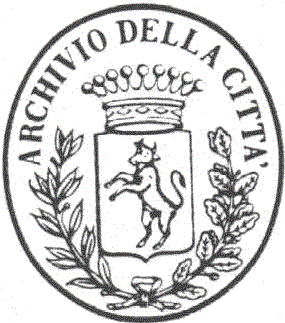|
The Homeopathic
Pharmacy
 A
curious fate intended that the "magnificent" homeopathic
pharmacy, founded in 1862 by Pietro Arnulfi in Turin, then taken
over by the "Homeopathic Institute" in 1876, annexed
to the Italian Homeopathic hospital in 1929 and inherited by
the City Council of Turin in 1985, should be set up once again
on the threshold of the third millennium in the new quarters
housing the Historical Archives of the City of Turin. The history
of this pharmacy was linked to the alternating fortunes that
homeopathy met with in Italy, and especially in Piedmont. The
old "new art of healing" was founded on the "laws
of likes", and experimented and theorised between the 18th
and 19th centuries by the Saxon physician Samuel Hahnemann (Meissen,
1755 - Paris, 1843). Homeopathy was introduced into the Kingdom
of the Two Sicilies with the encouragement of Francis I and Ferdinand
II of Bourbon, who respectively wanted it to be used in 1828
in the military Hospital of the Trinity in Palermo and in 1837
as a cure during the epidemic of "Asian malaise". In
the 1830s it arrived in Lucca and from there spread to Genoa
and then Turin, where it was widely opposed. The Piedmontese
followers of the exact sciences certainly did not award it their
seal of approval. In 1838 the Magistrato del Protomedicato [Order
of Physicians] in the Royal University of Turin observed: "the
preparation of most homeopathic remedies is not considered in
the legal pharmacopoeia". However, whether out of curiosity
or a certain fancy towards it, Charles Albert countered the reservations
advanced by the official bodies about the presumed abuses connected
to the practice of "medicine of similia" with a decidedly
laissez faire attitude. The illustrious members of that alliance
were told: "His Royal Highness sees fit to let the action
of time discredit the practice of homeopathic cures if they should
indeed be revealed as illusory or fanciful, or else bring to
light whether they can be of any real use". The sovereign's
intention was explicit: "For now nothing will be done about
the practice of that system every time that it is used by persons
properly authorised to exercise in Medicine or Surgery and that,
likewise, for now they must not be harassed for dispensing remedies
of homeopathic treatment". Freedom therefore; not unconditional
licence. A
curious fate intended that the "magnificent" homeopathic
pharmacy, founded in 1862 by Pietro Arnulfi in Turin, then taken
over by the "Homeopathic Institute" in 1876, annexed
to the Italian Homeopathic hospital in 1929 and inherited by
the City Council of Turin in 1985, should be set up once again
on the threshold of the third millennium in the new quarters
housing the Historical Archives of the City of Turin. The history
of this pharmacy was linked to the alternating fortunes that
homeopathy met with in Italy, and especially in Piedmont. The
old "new art of healing" was founded on the "laws
of likes", and experimented and theorised between the 18th
and 19th centuries by the Saxon physician Samuel Hahnemann (Meissen,
1755 - Paris, 1843). Homeopathy was introduced into the Kingdom
of the Two Sicilies with the encouragement of Francis I and Ferdinand
II of Bourbon, who respectively wanted it to be used in 1828
in the military Hospital of the Trinity in Palermo and in 1837
as a cure during the epidemic of "Asian malaise". In
the 1830s it arrived in Lucca and from there spread to Genoa
and then Turin, where it was widely opposed. The Piedmontese
followers of the exact sciences certainly did not award it their
seal of approval. In 1838 the Magistrato del Protomedicato [Order
of Physicians] in the Royal University of Turin observed: "the
preparation of most homeopathic remedies is not considered in
the legal pharmacopoeia". However, whether out of curiosity
or a certain fancy towards it, Charles Albert countered the reservations
advanced by the official bodies about the presumed abuses connected
to the practice of "medicine of similia" with a decidedly
laissez faire attitude. The illustrious members of that alliance
were told: "His Royal Highness sees fit to let the action
of time discredit the practice of homeopathic cures if they should
indeed be revealed as illusory or fanciful, or else bring to
light whether they can be of any real use". The sovereign's
intention was explicit: "For now nothing will be done about
the practice of that system every time that it is used by persons
properly authorised to exercise in Medicine or Surgery and that,
likewise, for now they must not be harassed for dispensing remedies
of homeopathic treatment". Freedom therefore; not unconditional
licence.
Nevertheless, a certain scepticism remained towards the new "doctrine",
while an absence of any set rules generated frequent misunderstandings
between physicians and pharmacists. The College of Apothecaries
of Turin sent petitions to the king against the homeopaths' widespread
practice of stocking and directly selling remedies prescribed
by the homeopathic physicians themselves. By royal order of 9
February 1839, the "apothecaries legitimately authorised
to practice Pharmacy in the capital and in other towns and territories"
were allowed to keep "medicinals of homeopathic remedies
in a separate place from ordinary medicinals" and the "collegiate
pharmacist" Domenico Blenghini was allowed to open a specialist
pharmacy in the Piedmontese capital. Consequently the "provision
of homeopathic medicines […] by attending physicians"
was prohibited. With this and other subsequent measures concerning
the activity of the Order of Physicians and the practice of the
professions dependent on it, the king thus re-established order
in the sensitive sector that ruled the health of his subjects.
However, the diatribe between allopaths and homeopaths continued.
Despite this, a Society of Physicians started up the Giornale
di Medicina Omeopatica in 1848 in Turin, with a forward by Maurizio
Poeti. The branch of medicine inspired by the rule of similia
similibus curantur seemed to attract many illustrious converts,
such as Vincenzo Gioberti and Antonio Rosmini, both excellent
surgeons, and Lorenzo Granetti, director of the Cottolengo Hospital
in 1848, and an ever-wider following, including the marchesa
Giulia Falletti di Barolo. In the Piedmontese capital, a second
homeopathic pharmacy, belonging to Vincenzo Vernetti, was opened
in the 1850s in Via Carlo Alberto, facing the Café Dilej
and close to Blenghini's pharmacy in Contrada Santa Maria. Meanwhile,
the advocates of homeopathy began to develop various types of
associations, in Turin as elsewhere, that were even open to women:
Clotilde Berta Varetti was enrolled as a member of the Accademia
ed Associazione Omeopatica Taurina in 1850. As the Guides to
the city recorded a gradual increase in "physician-surgeon-homeopaths",
new specialised pharmacies sprang up - one, for example, belonging
to Carlo di Cerruti in Contrada di Po in 1855 - that were regularly
subject to the "officially ordered visits to ordinary pharmacies",
and bound like them to observe the tariffs in force.
In 1862, in Contrada della Provvidenza (today Via XX Settembre),
"next to number 1", Pietro Arnulfi's above-mentioned
homeopathic pharmacy opened its doors, with splendid furnishings
"in cherry wood, painted black" with "gilt decorations",
with austere shelving and tight rows of small drawers, each destined
to contain a single substance, to avoid any contamination: a
real archive of products for infinitesimal confections. In joint
"ownership and management", this flourishing pharmacy
was taken over in 1876 by the "Homeopathic Institute",
a private association of physicians, pharmacists, veterinary
surgeons, followers and sympathisers of the "homeopathic
medical school" that widened its range of actions to a national
level in 1882. The Italian Homeopathic Institute, as this association
was called, "was founded with the aim of developing and
diffusing the practice of homeopathy throughout Italy by all
legal means". Initially it proposed "to open public
dispensaries in the main towns of the Kingdom, to sustain the
expenses of publishing a journal and to set up annual awards
to encourage experimental and explanatory notions of homeopathy".
In 1886 Humbert I decreed that it became a non profit-making
organisation. The next year, under the presidency of the doctor
Giuseppe Bonino and thanks to its unexpectedly prosperous financial
conditions, the assembly of "officials", representing
the two categories into which members had been divided - the
"physicians" and "benefactors" (from which,
by statute, "ladies were not excluded") -, was able
to decide the acquisition of a house in Via Orto Botanico (today
Via Lombroso) where a hospital would be established: the Italian
Homeopathic Hospital.
With just six beds in 1890, increased to twenty-two in 1903,
this hospital accommodated 473 patients in a little less than
fifteen years. In 1929, the former Arnulfi pharmacy was annexed
to it, transferred from its first site and now destined to prepare
exclusively the homeopathic remedies required by the patients.
But homeopathy, ever subject to alternating fortunes, lost a
large number of its followers over the next decade and the hospital
was de-classed to an "infirmary" and then reserved only for "chronic cases". The magnificent
furnishings of the pharmacy were left in a state of abandonment
and not even the war spared the Institute, which was however
revived with much effort during the years of reconstruction.
In 1972, the historic homeopathic Pharmacy, considered by some
"to be even more beautiful than the one in London",
was definitively closed to the public and quite forgotten. It
re-emerged from this oblivion in deplorable condition in 1985
when, with the Institute dissolved, the problem arose of finding
it a new owner, willing and interested to restore and preserve
it. Fortuitously and fortunately the City's Historical Archives
were appointed the task. At that time the Archives were waiting
to be moved elsewhere; with the realisation of their new quarters
in Via Barbaroux the Pharmacy, carefully restored, has finally
been given back to the public once more. Alongside the ampullae,
mortars and pestles once used for preparing homeopathic remedies,
the shelves are now filled with more than 250 surviving volumes
from the Institute's specialised library: 19th-century treatises,
rare periodicals from the early 20th century, and valuable manuals
saved from decay and dispersal and thus once more consultable
by those interested in the "medicine of likes" and
its history.
reserved only for "chronic cases". The magnificent
furnishings of the pharmacy were left in a state of abandonment
and not even the war spared the Institute, which was however
revived with much effort during the years of reconstruction.
In 1972, the historic homeopathic Pharmacy, considered by some
"to be even more beautiful than the one in London",
was definitively closed to the public and quite forgotten. It
re-emerged from this oblivion in deplorable condition in 1985
when, with the Institute dissolved, the problem arose of finding
it a new owner, willing and interested to restore and preserve
it. Fortuitously and fortunately the City's Historical Archives
were appointed the task. At that time the Archives were waiting
to be moved elsewhere; with the realisation of their new quarters
in Via Barbaroux the Pharmacy, carefully restored, has finally
been given back to the public once more. Alongside the ampullae,
mortars and pestles once used for preparing homeopathic remedies,
the shelves are now filled with more than 250 surviving volumes
from the Institute's specialised library: 19th-century treatises,
rare periodicals from the early 20th century, and valuable manuals
saved from decay and dispersal and thus once more consultable
by those interested in the "medicine of likes" and
its history.
Naturally, a privileged position has been reserved for certain
"sacred" texts by Samuel Hahnemmann: the Traité
de Matière médicale ou de l'action pure des médicaments
homeopathiques and the Doctrine et traitement homeopathique par
maladies chroniques, both translated into French from German
by A.-J.-L. Jourdan, a member of the Académie Royale de
Médecine, and published in Paris by Baillière in
1834 and 1846.
Rosanna Roccia
RETURN TO HOME
PAGE |

